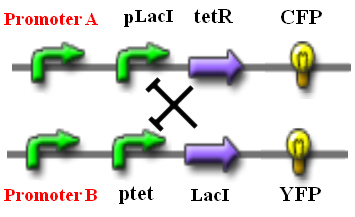Valencia/Comparator
From 2007.igem.org
| Line 1: | Line 1: | ||
| - | + | {{Valencia/}} | |
| - | + | ||
| - | + | During the brainstroming, an idea came up: mimetize an [[Electronic comparator|electronic comparator]] on a biologcal device. It still works with repressors, so it may sound familiar to most of us. | |
| - | + | '''What:''' | |
| - | + | Two inputs enter the system, a genetic circuit compares both signals and amplifies the higher one. | |
| - | + | '''How:''' | |
| - | + | ||
| - | + | So easy, I would be quite surprised if we don't find any drawback. | |
| - | The | + | Two different promoters that act as sensors of different inputs and two repressors that inhibit each other. |
| + | |||
| + | #We have two promoters that 'sense' something: psensor1 and psensor2 | ||
| + | #We have two promoters repressed: pLacI and ptet | ||
| + | #We also have two CDS of the repressors: lacI and tetR | ||
| + | #And, finally, we have the outputs: CFP and YFP | ||
| + | |||
| + | The system would be: | ||
| + | |||
| + | [[image:VComparatorSystem.jpg]] | ||
| + | |||
| + | So, if we have equal amount of whatever 1 and 2, there will be equal amounts of both repressors and, So, equal amounts of CFP and YFP. If some input 1 is sensibly higher than the 2, we will have more tetR that will inhibit ptet and we will have less YFP | ||
| + | |||
| + | '''What for:''' | ||
| + | |||
| + | We would have a device that would clear the noise of a system. | ||
| + | It can be used in other projects, as it implies only two genes and 4 promoters... | ||
| + | |||
| + | '''Problems:''' | ||
| + | * Will a gene driven by two different promoters work well enough?? ETH tried it with some results, why not give it a try? | ||
| + | * It's a small project, but it can be coupled to some other project... | ||
| + | * We still have to find some new BioBricks to build, as almost every single construction would be on the iGEM plate | ||
| + | |||
| + | '''Developed by:''' Arnau, Pablo and Javi | ||
Revision as of 07:41, 26 September 2007
During the brainstroming, an idea came up: mimetize an electronic comparator on a biologcal device. It still works with repressors, so it may sound familiar to most of us.
What:
Two inputs enter the system, a genetic circuit compares both signals and amplifies the higher one.
How:
So easy, I would be quite surprised if we don't find any drawback.
Two different promoters that act as sensors of different inputs and two repressors that inhibit each other.
- We have two promoters that 'sense' something: psensor1 and psensor2
- We have two promoters repressed: pLacI and ptet
- We also have two CDS of the repressors: lacI and tetR
- And, finally, we have the outputs: CFP and YFP
The system would be:
So, if we have equal amount of whatever 1 and 2, there will be equal amounts of both repressors and, So, equal amounts of CFP and YFP. If some input 1 is sensibly higher than the 2, we will have more tetR that will inhibit ptet and we will have less YFP
What for:
We would have a device that would clear the noise of a system. It can be used in other projects, as it implies only two genes and 4 promoters...
Problems:
- Will a gene driven by two different promoters work well enough?? ETH tried it with some results, why not give it a try?
- It's a small project, but it can be coupled to some other project...
- We still have to find some new BioBricks to build, as almost every single construction would be on the iGEM plate
Developed by: Arnau, Pablo and Javi
